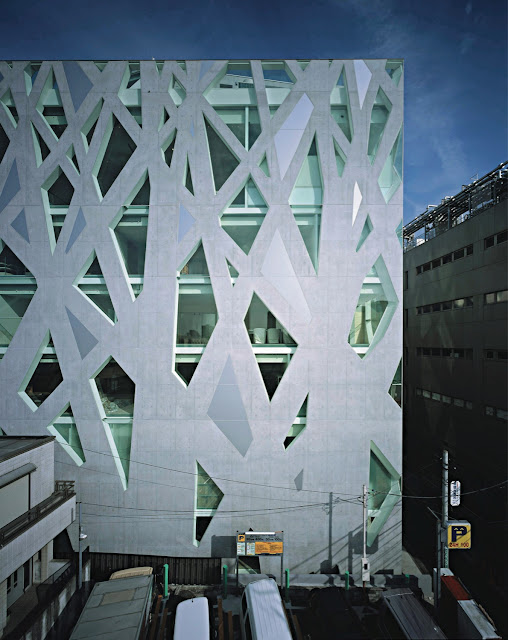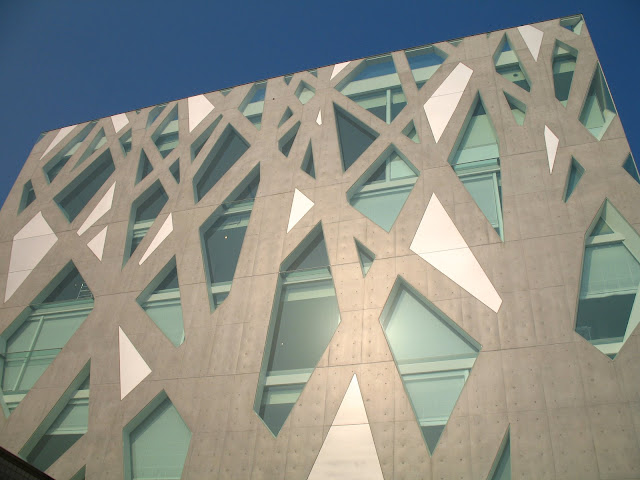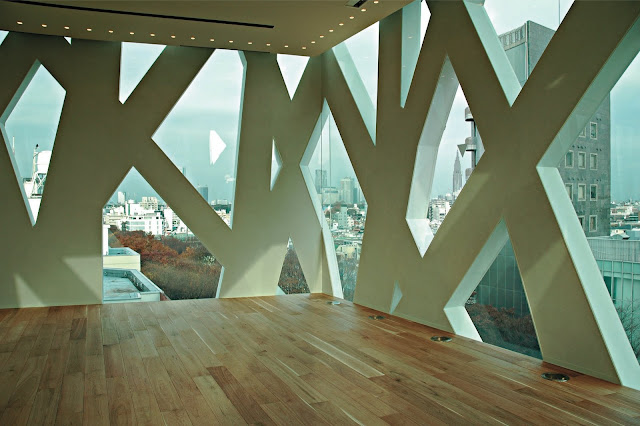Toyo Ito + Associates
Post By:Kitticoon Poopong
 |
| Photo © Courtesy of Toyo Ito + Associates |
 |
| Photo © Courtesy of Toyo Ito + Associates |
 |
| Photo © Courtesy of Toyo Ito + Associates |
 |
| Photo © Courtesy of Toyo Ito + Associates |
 |
| Photo © Courtesy of Toyo Ito + Associates |
 |
| Photo © Courtesy of Toyo Ito + Associates |
 |
| Photo © Courtesy of Toyo Ito + Associates |
Since the site is L-shaped and has a narrow frontage, in order to give the building a unified volume we enclosed the site with a wall that gives the impression of a row zelkova trees. This exterior surface serves as both graphic pattern and structural system, and is composed of 300mm-thick concrete and flush-mounted frameless glass. The resulting surface supports floor slabs spanning 10-15 meters without any internal columns.
 |
| Photo © Courtesy of Toyo Ito + Associates |
 |
| Photo © Courtesy of Toyo Ito + Associates |
 |
| Photo © Courtesy of Toyo Ito + Associates |
 |
| Photo © Courtesy of Toyo Ito + Associates |
 |
| Photo © Courtesy of Toyo Ito + Associates |
 |
| Photo © Courtesy of Toyo Ito + Associates |
 |
| Photo © Courtesy of Toyo Ito + Associates |
Our various studies started with the question, “How can we escape the conventional notion of a wall structure?” In other words, we were seeking a way to avoid transparent openings in an opaque volume. Instead of distinguishing transparency from opaqueness, we were seeking a new method that would simultaneously define and unite them – we were attempting to relate all the lines (columns), surfaces (walls), and openings in an innovative way. Our studies suddenly moved in a different direction after formulating the question: “Shouldn’t it be possible to create a surface as structure that directly expresses the flow of force, so long as it is formed as a structural diagram drawn as a pattern of thick lines on a flat surface?”
 |
| Photo © Courtesy of Toyo Ito + Associates |
 |
| Photo © Courtesy of Toyo Ito + Associates |
 |
| Photo © Courtesy of Toyo Ito + Associates |
 |
| Photo © Courtesy of Toyo Ito + Associates |
 |
| Photo © Courtesy of Toyo Ito + Associates |
 |
| Photo © Courtesy of Toyo Ito + Associates |
After passing through this process, the idea of using a structure composed of overlapping tree silhouettes was conceived, in a sense, suddenly. Our direction was set with a certain excitement when, following various investigations, we found that through the tree shape, we could order various conditions in an innovative way that is very different from conventional geometry. Trees are organisms that stand by themselves, and therefore their shape has an inherent structural rationality. The pattern of overlapped tree silhouettes also generates rational flows of force. Having adapted the branched tree diagram, as you move higher up the building, the thinner and more numerous the branches become, with a higher ratio of openings. Thus, the building unfolds as interior spaces with slightly different atmospheres relating to the various intended uses.
 |
| Photo © Courtesy of Toyo Ito + Associates |
 |
| Photo © Courtesy of Toyo Ito + Associates |
 |
| Photo © Courtesy of Toyo Ito + Associates |
 |
| Photo © Courtesy of Toyo Ito + Associates |
 |
| Photo © Courtesy of Toyo Ito + Associates |
 |
| Photo © Courtesy of Toyo Ito + Associates |
Rejecting the obvious distinctions between walls and openings, lines and planes, two- and three-dimensions, transparency and opaqueness, this building is characterized by distinctive type of abstractness. The tree silhouette creates a new image, with a constant tension generated between the building’s symbolic concreteness and its abstractness. For this project, we intended to create a building that through its architectural newness expresses both the vivid presence of a fashion brand and strength in the cityscape that will withstand the passage of time.
 |
| Photo © Courtesy of Toyo Ito + Associates |
 |
| Photo © Courtesy of Toyo Ito + Associates |
 |
| Photo © Courtesy of Toyo Ito + Associates |
 |
| Photo © Courtesy of Toyo Ito + Associates |
 |
| Photo © Courtesy of Toyo Ito + Associates |
 |
| location plan--drawing © Courtesy of Toyo Ito + Associates |
 |
| floor plans--drawing © Courtesy of Toyo Ito + Associates |
 |
| sections--drawing © Courtesy of Toyo Ito + Associates |
 |
| concept diagram--drawing © Courtesy of Toyo Ito + Associates |
Project name: Tod’s Omotesando Building
Location: Omotesando,Shibuya-ku, Tokyo, Japan
Location: Omotesando,Shibuya-ku, Tokyo, Japan
Program: Retail, Office
Period: 2002.4~2004.11
Period: 2002.4~2004.11
Structure: reinforced concrete, steel frame
Scale: 7 stories, 1 basement
Site Area: 516.23m2
Building Area: 401.55m2
Total Floor Area: 2,548.84m2
The people
The people
Client / Owner: Holpaf B.V.
Architect: Toyo Ito + Associates
Mechanical: ES Associates
Furniture design: Toyo Ito & Associates, Architects
Fixtures and fitting design: Modar srl, Garde U.S. P Co., Ltd.
General Contractor: Takenaka Corporationwww.takenaka.co.jp
Photographs: © Courtesy of Toyo Ito + Associates
Architect: Toyo Ito + Associates
Fujiya Building 1-19-4Design team: Toyo Ito, Takeo Higashi, Akihisa Hirata, Kaori Shikichi, Leo Yokota, Takuji Aoshima, Yasuaki Mizunuma
Shibuya, Shibuya-ku, Tokyo 150-0002 Japan
(phone) +81-(0)3-3409-5822
(fax) +81-(0)3-3409-5969
Mechanical: ES Associates
Furniture design: Toyo Ito & Associates, Architects
Fixtures and fitting design: Modar srl, Garde U.S. P Co., Ltd.
General Contractor: Takenaka Corporationwww.takenaka.co.jp
Photographs: © Courtesy of Toyo Ito + Associates
The products
Exterior CladdingMasonry: marble (travertine, used on rooftop floor) / Yabashi Marble Co., Ltd.
Concrete: acrylic silicone coating (clear base + pigment)
Roofing
Built-up roofing: sheet-applied membrane waterproofing, marble (travertine, W600mm x L600mm, T20mm) / Yabashi Marble Co., Ltd., planting (hair moss
Aluminum: aluminum panel (T5mm, fluoride resin finishing)
Glazing
Glass: float glass (double-grazed, T10mm + T10mm, for exterior), float glass (T10mm, for interior) / Asahi Glass Building Component Engineering CO., Ltd. www.agc.co.jp
Interior Finishes
Ceilings: plaster board (T12.5mm + T12.5mm, acrylic emulsion paint)
Walls:
- antico stucco T3mm, on plaster board (9.5mm + 9.5mm) or on plaster board (9.5mm + 9.5mm) + RC
- aluminum panel T3mm on plaster board (T9.5mm) + LGS
- natural leather panel T15+3mm on plaster board (T12.5mm) EP + LGS
- marble (travertine, W600mm x L600mm, T20mm) / Yabashi Marble Co., Ltd. on self-leveling (T15mm + RC)
- tile carpet (W500mm x L500mm) / Hasetora Spinning Co., Ltd.
- on OA flooring + RC
- walnut flooring (wax finishing) / Bozo Co., Ltd. on laminated veneer (T15mm) + OA flooring + RC
Niche (on the 1st, 2nd and 3rd floor): decorative natural wood laminate / Modar s.r.l.
Showcase: decorative natural wood laminate / Modar s.r.l.
Door / a part of wall: natural leather panel / Modar s.r.l, onPBbed
Lighting
Interior ambient lighting:
- low-volt mirror halogen lamp (12V50W, for ceiling)
- seamless line lamp (for display shelf)
- low-volt halogen lamp (12V50W, for spotlight)
Task lighting: fluorescent lamp (HF32W, for office)
Note>>Location in this map, indicate city/country but not exact address.

